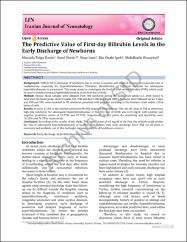The predictive value of first-day bilirubin levels in the early discharge of newborns
Künye
Ünsür, M. T., Kabakoğlu Ünsür, E., İnan, N., İpek, İ. Ö. ve Bozaykut, A. (2015). The predictive value of first-day bilirubin levels in the early discharge of newborns. Iranian Journal of Neonatology, 6(3), 1-5.Özet
Background: TORCH Early discharge of newborns due to social, economic and medical reasons increases the rate of readmissions, especially for hyperbilirubinemia. Therefore, identification of high-risk neonates for subsequent hyperbilirubinemia is paramount. This study aimed to investigate the level of total serum bilirubin (TSB), which could be used to predict neonatal hyperbilirubinemia at the first day of birth. Methods: Venous blood samples were obtained from 300 newborns during the postpartum period (i.e. 24±6 hours) to determine the blood group, direct Coombs test, TSB and direct bilirubin levels (DBL). Neonates were followed-up for 5 days, and TSB and DBL were recorded in 90 newborns presented with jaundice according to the Kramer's scale within 120±6 hours of birth. Results: In total, 23.3% of the studied newborns (N=90) required phototherapy. The cut-off value of TSB to determine high-risk newborns for subsequent hyperbilirubinemia at the first day of birth was 6.50 mg/dl with positive and negative predictive values of 19.75% and 97.72%, respectively. At this point, the sensitivity and specificity were 76.19% and 76.70%, respectively. Conclusion: According to the results of this study, TSB cut-off point of 6.5 mg/dl at the first day of birth could predict the risk of subsequent hyperbilirubinemia in healthy, term infants with early discharge. Since TSB cut-off point is economic and available, use of this method is recommended in all healthcare centers.
Scopus Q Kategorisi
Q3Kaynak
Iranian Journal of NeonatologyCilt
6Sayı
3Koleksiyonlar
- Makale Koleksiyonu [3770]
- Scopus İndeksli Yayınlar Koleksiyonu [6561]
- WoS İndeksli Yayınlar Koleksiyonu [6621]


















